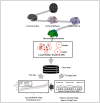Biological Brain Age Prediction Using Cortical Thickness Data: A Large Scale Cohort Study
- PMID: 30186151
- PMCID: PMC6113379
- DOI: 10.3389/fnagi.2018.00252
Biological Brain Age Prediction Using Cortical Thickness Data: A Large Scale Cohort Study
Abstract
Brain age estimation from anatomical features has been attracting more attention in recent years. This interest in brain age estimation is motivated by the importance of biological age prediction in health informatics, with an application to early prediction of neurocognitive disorders. It is well-known that normal brain aging follows a specific pattern, which enables researchers and practitioners to predict the age of a human's brain from its degeneration. In this paper, we model brain age predicted by cortical thickness data gathered from large cohort brain images. We collected 2,911 cognitively normal subjects (age 45-91 years) at a single medical center and acquired their brain magnetic resonance (MR) images. All images were acquired using the same scanner with the same protocol. We propose to first apply Sparse Group Lasso (SGL) for feature selection by utilizing the brain's anatomical grouping. Once the features are selected, a non-parametric non-linear regression using the Gaussian Process Regression (GPR) algorithm is applied to fit the final age prediction model. Experimental results demonstrate that the proposed method achieves the mean absolute error of 4.05 years, which is comparable with or superior to several recent methods. Our method can also be a critical tool for clinicians to differentiate patients with neurodegenerative brain disease by extracting a cortical thinning pattern associated with normal aging.
Keywords: Gaussian process; ROI; Sparse Group Lasso; aging; cortical lobe; cortical thickness; regression analysis.
Figures





References
-
- Alam S. B., Nakano R., Kobashi S. (2016). Brain age estimation using multiple regression analysis in brain MR images. IJICIC 12, 1385–1396. 10.24507/ijicic.12.04.1385 - DOI
LinkOut - more resources
Full Text Sources
Other Literature Sources

